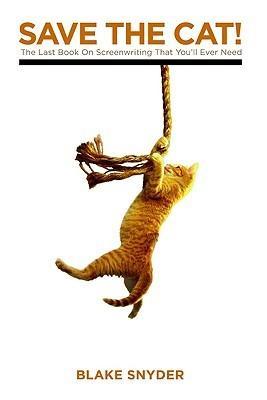Book: Save the Cat: The Last Book on Screenwriting You’ll Ever Need by Blake Snyder
Genre: Writing Book
Publisher: Michael Wiese Productions
Publication date: 2005
Pages: 195
Source: Purchased at Borders, according to the price sticker
 Summary: Save the Cat! by Blake Snyder takes the writer through a quick and fun process to test a story idea, match it up to a genre and find inspiring models, develop the lead character, and sketch the plot. The book finishes with some quick tips for revving up the completed screenplay and for marketing it to professionals in the industry.
Summary: Save the Cat! by Blake Snyder takes the writer through a quick and fun process to test a story idea, match it up to a genre and find inspiring models, develop the lead character, and sketch the plot. The book finishes with some quick tips for revving up the completed screenplay and for marketing it to professionals in the industry.
Thoughts: This is one of the writing books that I’ve used a lot but didn’t read from cover to cover until recently. It’s about screenwriting, but it’s a book that gets recommended during NaNoWriMo (National Novel Writing Month) for its quickly-grasped approach to story structure and for the advice about character encapsulated in the title.
I have page 70 marked permanently with a bright pink post-it note. This is the page with the Blake Snyder Beat Sheet (aka The BS2). This is similar to but more succinct than the structures that I explored in The Writer’s Journey (Book Review: The Writer’s Journey by Christopher Vogler) and 45 Master Characters (Book Review: 45 Master Characters by Victoria Lynn Schmidt).
The BS2 gives page numbers of the 110-page screenplay where each stage of the story is to take place. The break into the second act happens on page 25, the All is Lost moment happens on page 75. I don’t write screenplays, but with the simple use of ratios, I converted the numbers to my 90,000 word manuscript. If you don’t remember how to do ratios, ask your friendly neighborhood 6th grader. Or, ask me — for some reason ratios were the one thing that I loved so much about elementary mathematics that I never forgot how to do them.
At first, it seems like a story would get much too formulaic if it followed exact page numbers. If you worried, as I did, about formulas in The Writer’s Journey and 45 Master Characters (both books that left it up to the author how long to make each section of the structure) then, surely, this is going too far. But, it turns out it’s not. I kept experimenting with moving away from the structure, making the first half of Act Two short and Act Three long, among other trials, but, when I finally completed a detailed outline of my project, I brought it back in line with The BS2. It just seems to work.
Oh, and here’s the cat bit:
It’s the scene where we meet the hero and the hero does something — like saving a cat — that defines who he is and makes us, the audience, like him. p. xv
Appeal: If you’re writing anything that requires a narrative arc — a short story, a skit, a novel, a memoir, a screenplay — Save the Cat! will be useful. I have my suspicions that it would help if you were writing a plan for your career, an itinerary for a trip, or the text of a speech you need to give at a co-worker’s retirement party.
Reviews: Belle Wong, aka Ms. Bookish, used Save the Cat! to get her started with NaNoWriMo 2011: Saving the Cat This NaNoWriMo. Augusta Scattergood addressed the formula fear more directly in her review: Save the Cat. Helen Ginger reviewed Save the Cat (Book Review: Save the Cat!) and one of its follow-up books (Book Review: Save the Cat! Strikes Back). I didn’t know it was a series.
Have you read this book? What did you think?

